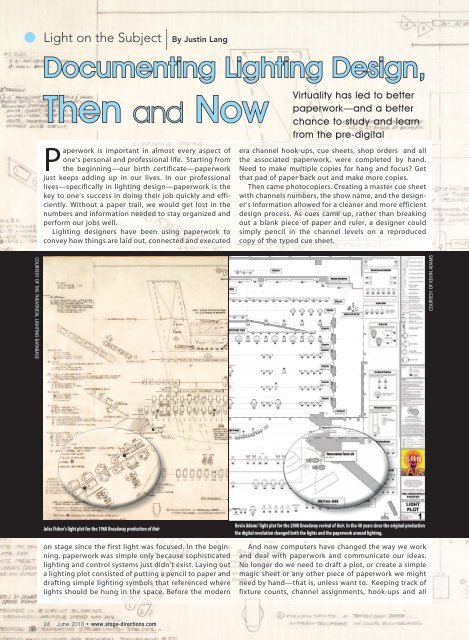Download a PDF - Stage Directions Magazine
Download a PDF - Stage Directions Magazine
Download a PDF - Stage Directions Magazine
You also want an ePaper? Increase the reach of your titles
YUMPU automatically turns print PDFs into web optimized ePapers that Google loves.
Light on the Subject<br />
|<br />
By Justin Lang<br />
Documenting Lighting Design,<br />
Then and Now<br />
Paperwork is important in almost every aspect of<br />
one’s personal and professional life. Starting from<br />
the beginning—our birth certificate—paperwork<br />
just keeps adding up in our lives. In our professional<br />
lives—specifically in lighting design—paperwork is the<br />
key to one’s success in doing their job quickly and efficiently.<br />
Without a paper trail, we would get lost in the<br />
numbers and information needed to stay organized and<br />
perform our jobs well.<br />
Lighting designers have been using paperwork to<br />
convey how things are laid out, connected and executed<br />
Virtuality has led to better<br />
paperwork—and a better<br />
chance to study and learn<br />
from the pre-digital<br />
era channel hook-ups, cue sheets, shop orders and all<br />
the associated paperwork, were completed by hand.<br />
Need to make multiple copies for hang and focus? Get<br />
that pad of paper back out and make more copies.<br />
Then came photocopiers. Creating a master cue sheet<br />
with channels numbers, the show name, and the designer’s<br />
information allowed for a cleaner and more efficient<br />
design process. As cues came up, rather than breaking<br />
out a blank piece of paper and ruler, a designer could<br />
simply pencil in the channel levels on a reproduced<br />
copy of the typed cue sheet.<br />
Courtesy of the Theatrical Lighting Database<br />
Courtesy of Kevin Adams<br />
Jules Fisher’s light plot for the 1968 Broadway production of Hair<br />
on stage since the first light was focused. In the beginning,<br />
paperwork was simple only because sophisticated<br />
lighting and control systems just didn’t exist. Laying out<br />
a lighting plot consisted of putting a pencil to paper and<br />
drafting simple lighting symbols that referenced where<br />
lights should be hung in the space. Before the modern<br />
Kevin Adams' light plot for the 2008 Broadway revival of Hair. In the 40 years since the original production<br />
the digital revolution changed both the lights and the paperwork around lighting.<br />
And now computers have changed the way we work<br />
and deal with paperwork and communicate our ideas.<br />
No longer do we need to draft a plot, or create a simple<br />
magic sheet or any other piece of paperwork we might<br />
need by hand—that is, unless want to. Keeping track of<br />
fixture counts, channel assignments, hook-ups and all<br />
24 June 2010 • www.stage-directions.com

















